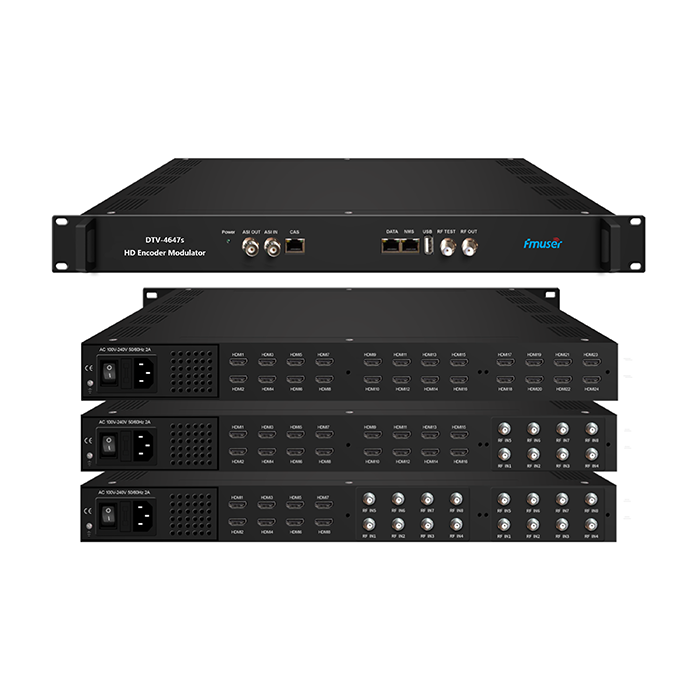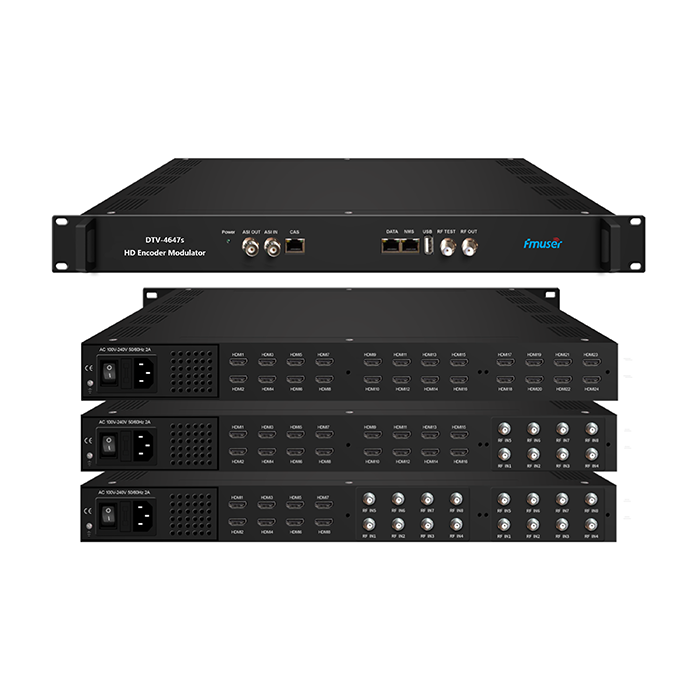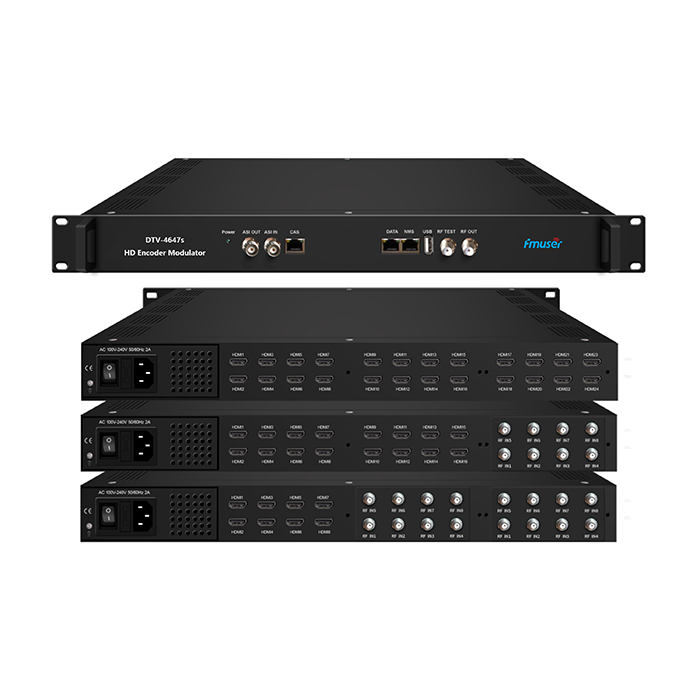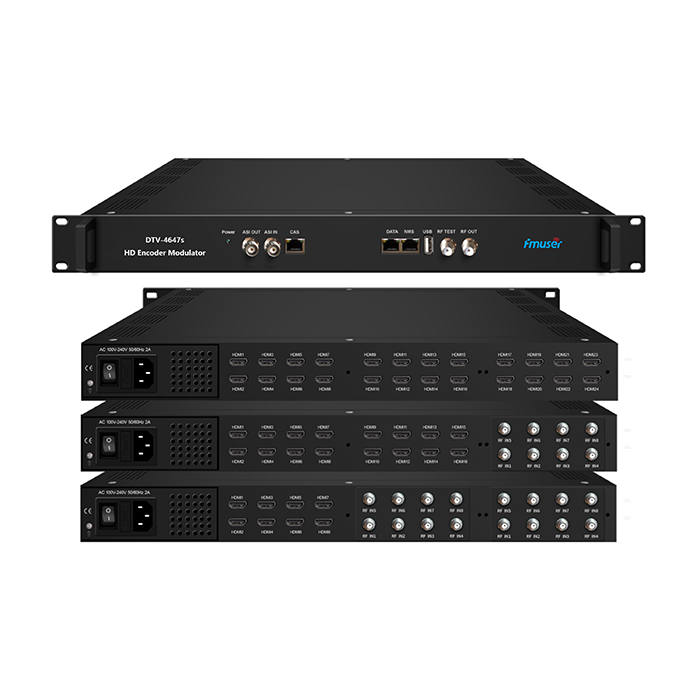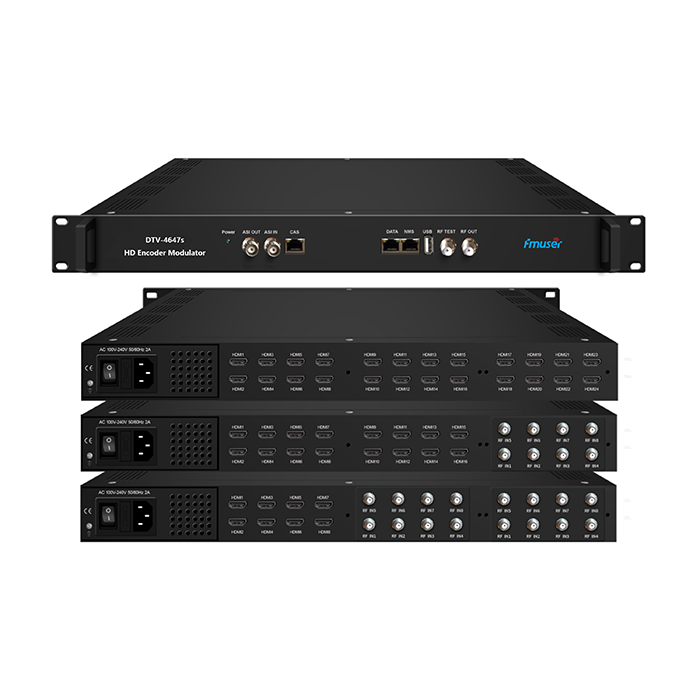
DTV Encoder Modulator
A Digital TV Encoder Modulator is a device used in digital headend systems to encode digital television signals. It takes the digital signals from the digital headend system and converts them into radio frequency signals for transmission. In a digital headend system, the Digital TV Encoder Modulator is usually the first device that is used to process the digital signals. The encoder modulator then modulates the signal and transmits it to the antenna or satellite dish. The modulated signal is then received by the TV receivers, which decode the signal and display the digital content. The Digital TV Encoder Modulator is an important component of any digital headend system and is responsible for ensuring that the digital content is delivered in a reliable and efficient manner.
-
![24 DVB-S/S2 to 8 DVB-T Encoder Modulator]()
-
![8/16 HDMI & 8/16 DVB-S/S2 to 8 DVB-T Encoder Modulator]()
-
![8/16/24 HDMI to 8 DVB-T, 12 QAM, or 6 ISDB-T Encoder Modulator]()
8/16/24 HDMI to 8 DVB-T, 12 QAM, or 6 ISDB-T Encoder Modulator
Price(USD):Ask for a quotation
Sold:27
-
![FMUSER 32/48 QAM with 8 HDMI to 4 QAM or 8 HDMI to 4 QAM Encoder Modulator]()
FMUSER 32/48 QAM with 8 HDMI to 4 QAM or 8 HDMI to 4 QAM Encoder Modulator
Price(USD):Ask for a quotation
Sold:67
-
![FMUSER 4, 8, 16, or 24 HDMI to 4 or 8 DVB-T Encoder Modulator]()
FMUSER 4, 8, 16, or 24 HDMI to 4 or 8 DVB-T Encoder Modulator
Price(USD):Ask for a quotation
Sold:141
- Why digital TV Encoder Modulator is important?
- A digital TV Encoder Modulator is important because it allows TV signals to be transmitted in digital format, rather than analog. This can provide improved picture and sound quality and can also allow for additional features such as interactive services, multiple audio and video streams, and data services.
- How many types of digital TV Encoder Modulator are there and what are the differences between each one of them?
- There are three main types of digital TV Encoder Modulators: Analog, Digital, and Hybrid.
Analog Encoder Modulators convert analog signals, such as radio and television broadcasts, into digital form for transmission. Digital Encoder Modulators convert digital signals, such as from a satellite or cable TV provider, into a form suitable for broadcast television. Hybrid Encoder Modulators combine features from both Analog and Digital Encoder Modulators, allowing for the input of both analog and digital signals.
- How to choose the best digital TV encoder modulator?
- Buying Guide for Digital TV Encoder Modulator for Each Application:
1. Broadcast Applications: When selecting a digital TV encoder modulator for broadcast applications, look for one with a high-quality analog video input with multiple video encoding formats, support for any type of digital video format, reliable audio encoding, and a low-latency output. Consider the output power and the number of modulation channels your broadcast application requires.
2. IPTV Applications: When selecting a digital TV encoder modulator for IPTV applications, look for one with multiple streaming and encoding formats, support for video on demand (VOD), reliable IP streaming, and a low-latency output. Consider the IPTV service platform you're using and the number of channels you need to encode.
3. Cable TV Applications: When selecting a digital TV encoder modulator for cable TV applications, look for one with high-quality analog video input, multiple video encoding formats, support for any type of digital video format, reliable audio encoding, low-latency output, and a multi-channel output. Consider the output power and the number of modulation channels your cable TV application requires.
4. OTT Applications: When selecting a digital TV encoder modulator for OTT applications, look for one with multiple streaming and encoding formats, support for video on demand (VOD), reliable IP streaming, and a low-latency output. Consider the OTT service platform you're using and the number of channels you need to encode. - Besides, always think twice before placing an order for such expensive device:
- 1. Research the features and specifications of different digital TV encoders and modulators. Make sure to take note of the broadcast frequency, video output, and modulation capabilities.
2. Consider the type of signal you want to transmit. Consider factors such as the type of channel, the type of broadcast, and the number of channels you want to transmit.
3. Compare the cost and availability of the different encoders and modulators. Make sure to compare the cost of installation and maintenance as well.
4. Check the reviews for the different encoders and modulators. This will give you a better idea of how reliable each product is.
5. Consider the customer service and warranty offered by the manufacturer. Make sure you’ll be able to get help with any issues you may have with the product.
6. Once you’ve chosen the best digital TV encoder modulator for your needs, place your order.
- What are the advantages of digtial TV encoder modulator over a single encoder or modulator?
- Using a digital TV Encoder Modulator has several advantages over using a single encoder or a single modulator:
1. It offers greater flexibility in encoding and modulating digital TV signals.
2. It is more cost-effective than using separate components.
3. It provides a single solution for all of your digital TV needs.
4. The integrated digital TV Encoder Modulator has a built-in scaler, allowing for the adjustment of video resolution and frame rate.
5. It offers the ability to encode and modulate up to 8 channels simultaneously.
6. It is easy to install and configure.
7. It has the ability to transmit digital signals over long distances.
8. It provides support for various digital TV standards, including ATSC, ISDB-T, DVB-T, and DVB-C.
- What are the main applications of a digtial TV encoder modulator?
- Digital TV Encoder Modulators are used in a variety of applications, including broadcast TV, cable TV, IPTV, satellite TV, and digital signage. They encode the digital TV signal into a format that can be broadcast over the air or transmitted over a cable line. They also modulate the signal so that it can be received and decoded by a TV receiver.
- What are the most important specifications of encoder modulator you should care?
- The most important specifications of digital TV Encoder Modulator that you should consider are the video resolution, audio quality, video and audio encoding, modulation format, RF output, and IP streaming capabilities. Other important specifications include the number of input channels, IPTV support, MPEG-2 and MPEG-4 support, and picture-in-picture capabilities. Additionally, buyers should consider the device's physical size, power consumption, and remote control support.
- How many types of protocals are there for DTV encoder modulator?
- There are two main types of protocols for digital TV Encoder Modulators: MPEG-2 and H.264. The choice between the two depends on the bandwidth available and the quality of the video that you want to achieve. MPEG-2 is typically better for higher bandwidth applications and provides higher video quality, while H.264 is better for lower bandwidth applications and provides better compression.
- How are you?
- I am fine
CONTACT US


FMUSER INTERNATIONAL GROUP LIMITED.
We are always providing our customers with reliable products and considerate services.
If you would like to keep touch with us directly, please go to contact us
